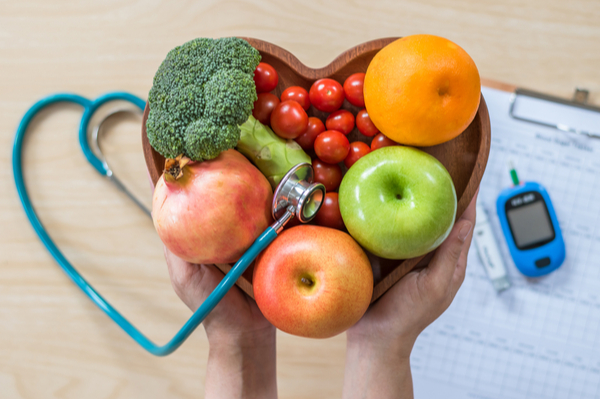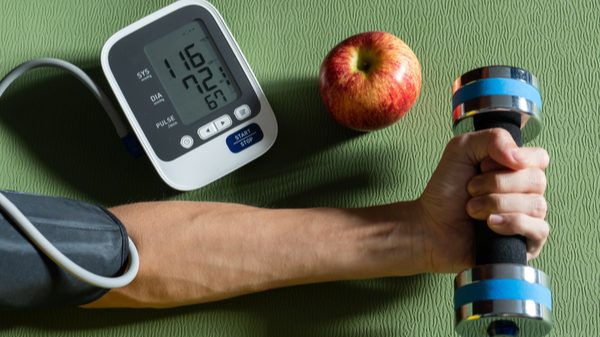The most common type of diabetes, Type 2 diabetes, should be taken care of, and their prevention is essential for health.
Prevention for any diabetes should be utmost importance especially if you have an increased risk of diabetes due to being overweight or consist of diabetes in family history or you have been diagnosed with prediabetes (which is also known as impaired fasting glucose).
The most effective way of diabetes prevention is consuming a healthy diet, being active physically and also shaving off a few extra pounds. It can always be started whenever you desire.
Allowing few alterations in your lifestyle may result in the prevention of more chronic and dangerous health issues that may occur otherwise in future, such as nerve, kidney and heart damage.
What’s the best diet for diabetes?
A person’s nutritional needs are essentially the same with no special requirements, even if trying to avoid developing or controlling diabetes. However, it is still important to note some of your food choices, especially your carbohydrate intake.
It is better if you decide to lose your weight, rather than follow the Mediterranean or other healthy-healthy diets to help. Just losing your weight for up to 5 or even 10% can help reduce your blood sugar, blood pressure, and cholesterol levels.
Trying to consume a healthy diet or lose weight can have a positive effect on your mood, energy, and cause a good sense of wellbeing.
People suffering from diabetes are more liable to develop heart problems, nearly double those not having diabetes or are more at risk for mental health disorders like depression.
The biggest risk for diabetes: belly fat
The major risk of getting Type 2 diabetes comes from being obese or overweight. Even still, the risks keep getting high if you carry your weight in your abdomen rather than in the hips and thighs.
Belly fat is associated with insulin resistance when found around the liver or any other abdominal organs. Your risk of getting diabetes increases substantially if you are:
- A woman is having a waist circumference of 35 inches or more.
- A man is having a waist circumference of 40 inches or more.
Your abdomen weight is increased due to gaining calories from fructose present in sugary beverages like soda, energy and sports drinks, coffee drinks, and processed foods like cereal, muffins, doughnuts, and granola bars.
Diabetes chances are reduced if you consume fewer amounts of sugary substances, which can lead to a slimmer waistline.
Planning a diabetes diet
You should not leave everything that you like to start a diabetic diet and not make this complicated. It should be started by differentiating myths from facts related to diets that can maintain or prevent diabetes.
Myths and facts about diabetes and diet
· Myth: Sugar should be avoided most of all.
Fact: You can take your desired treats, but if you plan it appropriately and limit your sugar intake. If it is added as a part of a healthy diet plan, then dessert can be taken.
· Myth: Carbs should be cut down to a minimum.
Fact: The amount of serving that you take, and the type of carbohydrate that you consume is an essential key. More whole-grain carbs should be taken rather than starchy carbs as they contain high amounts of fiber that helps to digest slowly, maintain blood sugar levels.
· Myth: You require special diabetic meals.
Fact: Being a diabetic or not, the concept of eating healthy is the same in every case. No positive result is seen in expensive diabetic foods.
· Myth: It is good if your diet is high in protein.
Fact: An important factor in diabetes is insulin resistance, which may be enhanced due to more than usual uptake of protein, especially those obtained from animals, as shown in studies.
Your diet should contain protein, fats, and carbohydrates in moderation. All three are required by the body to function appropriately. Having a balanced diet is essential for this.
A healthy eating program consists of taking note of your overall dietary pattern instead of worrying about some certain types of foods. You should avoid packaged, and convenience food more and start taking natural and unprocessed food.
Choose high-fiber, slow-release carbs.
You should worry more about what types of carbs you take because they are essential in affecting your blood sugar levels, more than fats or proteins ever do.
You should not consume refined carbohydrates like pasta, white bread, and rice, even soda, candy, snack foods, and packaged meals. Slow-release carbs should be your goal, which is high in fiber contents of carbohydrates. Your body produces less insulin in their intake, as they are digested more slowly.
What about the glycemic index?
Foods that are low in glycemic index (GI) do not affect blood sugar mostly, while those high in glycemic index raise your sugar levels quickly. GI is used widely as a management technique to note your blood sugar levels; some shortcomings are still seen.
- GI does not give an estimation of food’s healthfulness.
- Health benefits related to GI are still not clear.
- Using the GI table as a guide makes everything complicated.
- Your diet is improved when you follow the Mediterranean or other heart-healthy diets that help you to decrease your glycemic levels, which is mentioned in many studies.
Be smart about sweets.
Starting a diabetic diet does not ensure the removal of sugary substances, but it is common that people usually take sugar more than is considered healthy. Everything should be taken in moderation. Even in diabetes, you can enjoy dessert if it is not in large quantities.
Your desire for sweets should be reduced by eliminating sugar little by little so as to alter your taste buds accordingly.
Try cutting off on bread (or rice or pasta) if you want dessert: Heavy carb foods should be cut off if you desire to eat sweet dessert because these add extra carbohydrates.
Healthy fat should be included in the dessert: Fats tend to slow down digestion which causes low blood sugar level rise. But it does not indicate that you should consume doughnuts more. Rather healthy fats like yogurt, peanut butter, ricotta cheese, or nuts.
Sweets should not be taken alone but as a meal: Sweets tend to increase your sugar levels when taken alone. But if you ingest them as part of a proper meal rather than alone, then your sugar level does not elevate rapidly.
Savor each bite of your dessert: Can you count the times that you savagely dug into a bag of cookies or a huge piece of cake? Did you really enjoy every bite of it?
You should savor every flavor and texture with each bite of your sweet. You will be able to appreciate it more and are more likely to eat moderately.
Tricks for cutting down on sugar
- Reduce soft drinks, soda, and juice. 15% chances of diabetes are increased with every serving of 12 oz. of sugary sweet beverage that you consume on a daily basis. Replace it with sparkling water, with an added touch of lemon or lime. Do not add creamers or sweeteners to your tea or coffee.
- Saturated fat should not be replaced with sugar. We think we are smart and healthy when we replace saturated fats like whole milk dairy with that of refined carbs. It means nothing if your low-fat has been substituted with added sugar.
- Sweeten foods yourself. Get stuff which is unsweetened like plain yogurt, iced tea, or unflavored oatmeal, and include any sweetener (fruit) yourself. The sugar you will add will be less than that added by the manufacturer.
- Check labels and try to get low-level sugar items and use fresh and organic food instead of canned ones. Take note of sugar contents in cereals and sugary drinks.
- Try to avoid getting packaged foods like frozen dinners, canned soups, or low-fat meals that have masked sugar content. Eat home-cooked meals more.
- Limit sugar used in recipes from ¼ to 1/3. Sweetness can be increased using mint, cinnamon, nutmeg or vanilla extract rather than using pure sugar.
- Try to satisfy your craving healthily. Rather than eating ice cream, make a blend of frozen bananas to produce a creamy treat. Or you can eat dark chocolate rather than pure milk chocolate.
- Try eating half of the amount of dessert that you usually eat, and replace the other half with fruit.
Choose fats wisely
Fats should be selected with great care, as some are unhealthy, while others can be beneficial somehow.
- Unhealthy (saturated) fats. These are present in red meat, tropical oils or dairy, you should not totally cut off saturated fats but rather take them in moderation. It is advised by the American Diabetes Association to take 10% of your daily calories from saturated fats.
- Healthy (unsaturated) fats. Fats obtained from fish and plants like olive oil, nuts and avocados are unsaturated fats which are also considered healthy. Brain and heart health is improved using Omega-3 fatty acids; inflammation is also fought by using this. These are present in tuna, salmon, and flax seeds.
Eat regularly
Diabetes and its risk can be cut back to half if you lose about 7% of your total body weight, which is a comforting thought. You can avoid starving yourself and are not asked to note your calories count.
The strategy that helps the most is by noting down what you eat and having regular meals at the regular time.
Eat at regularly set times. A person having regular meals at proper times have a body which is able to maintain its blood sugar levels and weight. Moderate sizes and portion of meals should be made.
- Try taking a good breakfast when you start your day. Enough energy will be gained, and the sugar level will remain steady.
- Take six small meals per day. Your portion size can be checked if you eat daily.
- Calorie intake should be the same. Try eating the same amount each and every day, rather than overeating one day and not eating enough the other day.
Get more active
Insulin sensitivity and weight can be regulated healthily with exercise. You should start with walking for 30 minutes per day (or even 10 minutes for three times). Other activities like biking, swimming, or other normal level activity can be done too to induce sweat.
Natural ways to prevent diabetes before it starts
- Quit smoking if you are a smoker. Type 2 diabetes can develop easily in people who smoke, as smoking can cause insulin resistance. Quitting can lessen the risk of Type 2 diabetes with time.
- Watch your portions. Diabetes can be avoided if you reduce your food portions and size, which can lessen the production of insulin and blood sugar. Taking too much food at a particular time has known to induce greater sugar levels and insulin levels in people at risk.
- Aim for 30. You should try to stay active by walking, dancing, swimming, or lifting weight for 30 minutes, for five days a week. If you are lazy or have little physical activity, then you have an inactive life, and it’s time for a change.
- Drink water. Diabetes can be avoided if you drink large amounts of water, as it helps with sugar control and insulin levels. Using water more instead of other sugary beverages helps to avoid sugar or any other undesired content.
Final Verdict
A proper nutritional diet can be constructed with the help of a healthcare professional with people suffering from diabetes. Leading a balanced life and eating healthy improves diabetes and helps to avoid its complications by:
- Lowering inflammation
- Lowering heart disease risks
- Enhancing antioxidant activity
- Maintaining blood sugar levels.
- Reducing the risk of kidney disease
Pregnant women can ask their medical care givers to devise a diet plan if they have gestational diabetes, so as to prevent any harm from coming to their babies, and to keep them healthy.













